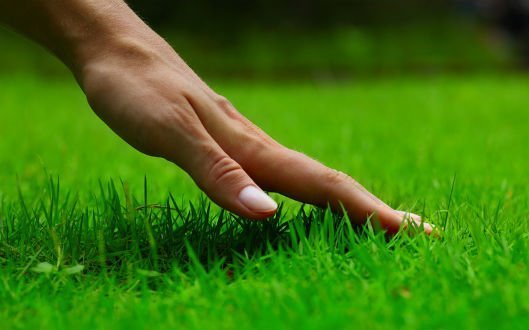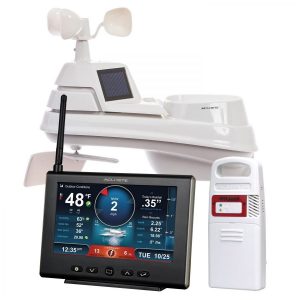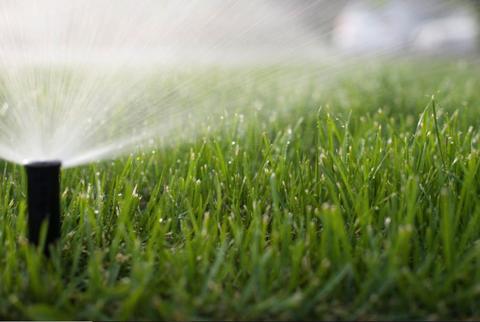Reading time: 6 minutes
There’s nothing quite like stepping out onto a perfect lawn on a warm spring morning. The dew still clings to the grass, and the sun is just starting to peek over the horizon. If you’re lucky, you might even hear the birds chirping in the distance.
At first appearance, the lush lawn surrounding a suburban home would seem like a simple decorative affectation. However, the practice of keeping the perfect lawn as low-cut vegetation around a dwelling has a very practical origin.
Of course, achieving that perfect lawn takes some work – but it’s definitely worth it! Here are the perfect lawn care tips and tools to help you get started.
Jump ahead to:
The Perfect Modern Lawn
Hopefully, you do not have to worry about enemy forces laying siege to your suburban bungalow, but there are still some very good reasons to maintain a healthy lawn around the house.
Not only does it drive up the curb appeal of your property, but a lush, cool and perfect lawn can also help keep the house cooler during the hot summer months. It gives the kids a safe place to play outside of the house, and can provide the homeowner a refreshing extra room. What could be nicer after a busy day than relaxing outside on a cool lawn?
Many neighborhoods and homeowners’ associations require residents to maintain an attractive lawn so as to protect everyone’s property values. These requirements are more often relaxed during times of drought and water rationing. However, a healthy and well-watered lawn has the added benefit of contributing to fire safety.
Lawns are more likely to thrive in the wet conditions which are common in the Old World, but, keeping a perfect lawn in North America usually requires some additional irrigation. For decades, this has meant simply turning on the sprinkler and hoping that you remember to turn it off after an hour or so. In fact, it is not uncommon to see sprinkler systems running in the middle of a rain storm!
Grass is a remarkably resilient plant, which means that your lawn will likely survive if conditions are less than perfect. You don’t have to mow your lawn if you don’t water it, but if the grass is healthy, it will crowd out weeds. Kidding aside, mowing the grass can be a healthy and relaxing activity, and it contributes to the perfect modern lawn.
Your Lawn and the Weather
Over-irrigation can be as stressful for your lawn as not watering enough. Experts generally agree that the grass varieties which make up most lawns in North America will thrive if they are given between one and two inches of water each week.
To find out how long you should run your sprinklers, you have to know how much water the lawn is getting from natural rainfall. And, the best way to find your local rainfall amount is to take a reading from your personal Weather Station. If you need a simpler and cheaper solution, invest in a rain gauge.
Weather Gadgets For The Perfect Lawn Care
AcuRite 01024 Pro Weather Station
This is one of the most popular weather stations on the market and comes with an easy to read and programme HD display. It helps you to determine precise weather conditions, indoor comfort and daily record dashboards. You can easily mount the sensor outside and plugin the display to get accurate readings and weather updates.
If you are looking forward to getting periodic rainfall updates for a perfect lawn, this can be a really good option for you. Also, this comes with a sleep mode that can be turned on for while you go to sleep.
The Barometer depicts highly reliable future forecasts so that you can easily plan your tours and upcoming events. It even keeps a record of outdoor temperature and humidity up to 1 year of weekly high and low records. A digital clock automatically updates itself according to daylight saving features and it includes an alarm clock. You can set customizable alarms for temperature, wind speed, humidity, rainfall, etc.
- Size: 0.6 x 7.6 x 5.5 inches
- Wind Direction: 16 points
- Temperature Accuracy: +/-2 degree F
- Humidity Accuracy: +/-3 %
- Transmission Frequency: 18-36 seconds depends on the measurement
- Lightning Detector Range: 25 miles(40 km)
- Wireless range: 330 feet
Pros & Cons
- Easy to setup
- Bright, colorful and clear display
- Wide Range
- Accurate outdoor reading
- Has a Night mode
- Customizable alarms
- Less accurate indoor reading
- No battery backup for power cuts
Oregon Scientific Rain Gauge
An Oregon Scientific Rain Gauge is easily our favourite rain gauge for the home gardener and lawn lover.
It’s completely weather resistant, has a quality rain gauge as well as our favourite feature – it is self emptying. One of the most accurate rain guages on the market with its accuracy up to 0.4 inch increments, it also records temperature and humidity.
The transmission range of this rain guage is fantastic. It can transmit data from 300 feet away meaning you have more choices as to where you place your gauge.
Think thats all the amazing features this machine has? Think again! This amazing rain gauge has a 10 day data history record ability making it one of the longer storage systems.
Finally, it can track the amount of water you use to water your lawn which gives you the edge when trying to grow the perfect lawn. When you combine the 10 day data record with your personal watering you can easily achieve the perfect lawn!
- Size: 3.54 x 5.59 x 0.98 inches
- Accuracy: Up to 0.4 inches
- Wireless Transmission: Up to 300 feet
- Data Collection: 10 Days
- Power Source: 4 AA Batteries
Pros & Cons
- Easy to setup
- Bright and clear display
- Wide Range
- Accurate outdoor reading
- Easy to read
- Wireless
- Change batteries regulalry
- Poor technical support
The Weather And A Sprinkler System Combined
Now that you have a handle on how much water nature is providing your lawn, you can determine how much you need to add with your sprinkler system.
We can find the efficiency of your sprinkler system with this simple experiment. If you are using a sprinkler attached to a garden hose, find an empty tuna can and place it on the ground, open side up, near the center of the sprinkler’s spray pattern. Turn on the sprinkler and monitor the amount of time it takes for half an inch of water to collect in the can.
You can use a similar procedure with an installed sprinkler system, but you may want to test in several places in your yard to ensure that your system is watering evenly.
What Is The Best Time To Water Your Lawn
Watering during the heat of the day leads to water loss from evaporation. In fact, it is also thought that sunlight shining through the lens created by a water droplet on a flower blossom can lead to sunburn damage in your flowerbeds.
Watering at night or just before, or after, sundown means that your lawn will be wet all night! This may encourage fungus and disease growth. We recommend to turn your sprinklers on as early in the morning as you can. It will be cooler with less wind early in the morning. This means less evaporation and the full day’s sunlight will discourage fungus and disease.
Turning the sprinklers on once or twice a week for a decent time is thought to be more beneficial than watering daily for a short amount of time. Frequent watering, even frequent deep watering, will encourage shallow root growth.
A longer watering period allows the water to soak in more effectively, but there is a danger of watering too long in a session. Our experts recommend trying different time periods and monitor the health of your grass. If having a perfect lawn is what you are looking for, some data collection may just be required.
Understand that each season will require different levels of water. Grass grows very little during winter, and, if you live in an area that is affected by frost or snow, adding moisture is a major no-no! Once spring arrives, watch for signs of wilting as the weather warms and ensure to add some fertiliser as the grass comes back to life. Then, in the summer months, keep moisture levels even with some deep watering to create the perfect lawn and be the envy of your neighbourhood.
Water Your Lawn Early In The Morning
Remember when we mentioned rainfall rates during our discussion of rain gauges? A summer thunderstorm can dump several inches of rain in a small area in a very short amount of time.
However, not all of that rain will soak into the soil where the roots of your lawn can use it. The same thing may occur if you run your sprinklers for too long. If puddles begin to form in your lawn, you may encounter runoff.
Sprinkler water running down the street and not soaking into the soil is wasted and costing you money! It may be more beneficial to turn on the sprinkler for ten or twenty minutes, turn it off for a bit to allow the water to soak into the soil, and then turn on the sprinkler again.
The “screwdriver test” is a good way to judge whether or not you are getting a sufficient soak. If you can easily push a six-inch screwdriver into the soil, then when you remove it there’s soil coating the screwdriver shaft, your lawn is getting a good soak. If the screwdriver comes out dry, you need to give your lawn more water.
The Proper Way Of Mowing For A Perfect Lawn Care
We recommend that you set your mower to a higher setting. Mowing to 2 1/2 to 3 inches has several advantages when looking to create the perfect lawn.
- The longer grass blades will have more leaf area, so the lawn will absorb more energy from the sun.
- That taller grass will shade the soil, helping it to hold on to the moisture and keeping weeds from getting enough sun to become established.
- Frequent mowing will keep the lawn looking great, and leave the short clippings so that they can return their nutrients to the soil.
- Using a hand mower also has all of the benefits of jogging while beautifying your home!
Keep These Concepts In Mind To Create The Perfect Lawn Care

- Measure how much water your sprinkler system delivers in a set period of time versus how much rain has fallen on your lawn over the past week. Use an empty tuna can and a rain gauge for this experiment.
- Occasional deep watering is more beneficial to your grass’s root system than frequent watering.
- Monitor the sprinkler rate to avoid a runoff. Turn off the water before puddles form and allow it to soak in.
- A healthy perfect lawn with thick, grass will naturally drive out weeds.
- Grass mowed to 2 1/2” to 3” while shading the soil, will help to retain moisture and retard weed growth.
- Remember that your lawn lives outside, in the weather, and that a healthy, inviting and perfect lawn will encourage your family to spend more time out there, too.
Taking care of your lawn is easy and enjoyable when you are armed with these simple tips and the rainfall and weather information gleaned from your home weather station.
Also, check out our recent post on the top-selling rain gauge.





